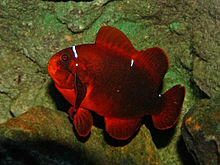Maroon clownfish
| Maroon clownfish | |
|---|---|
 |
|
| Scientific classification | |
| Kingdom: | Animalia |
| Phylum: | Chordata |
| Class: | Actinopterygii |
| Order: | Perciformes |
| Family: | Pomacentridae |
| Subfamily: | Amphiprioninae |
| Genus: |
Premnas Cuvier, 1816 |
| Species: | P. biaculeatus |
| Binomial name | |
|
Premnas biaculeatus (Bloch, 1790) |
|
| Synonyms | |
|
Chaetodon biaculeatus Bloch, 1790 |
|
Chaetodon biaculeatus Bloch, 1790
Holocentrus sonnerat Lacepède, 1802
Lutianus trifasciatus Schneider, 1801
Premnas epigrammata Fowler, 1904
Premnas gibbosus Castelnau, 1875
Premnas semicinctus Cuvier, 1830
Premnas unicolor Cuvier, 1829
Sargus ensifer Gronow, 1854
Premnas biaculeatus, commonly known as spine-cheeked anemonefish or the maroon clownfish, is a species of anemonefish that is found in the Indo-Pacific from western Indonesia to Taiwan and the Great Barrier Reef. They can grow up to be about 17 centimetres (6.7 in). Like all anemonefishes it forms a symbiotic mutualism with sea anemones and is unaffected by the stinging tentacles of the host anemone. It is a sequential hermaphrodite with a strict sized based dominance hierarchy: the female is largest, the breeding male is second largest, and the male non-breeders get progressively smaller as the hierarchy descends. They exhibit protandry, meaning the breeding male will change to female if the sole breeding female dies, with the largest non-breeder becomes the breeding male. The fish's natural diet includes algae and zooplankton.
The characteristic that defines this genus is the spine on the cheek. The color of the body and bars varies according to sex and geographic location. Despite the common name of Maroon clownfish, only some females have a maroon body color, with a range of color to dark brown. Juveniles and males are bright red-orange. The fish has three body bars which may be white, grey or yellow. Where the female bars are grey, they can be "switched" rapidly to white if fish is provoked. The sized based dominance hierarchy means in any group of anemonefish the female is always larger than the male. There is a significant difference in size for this species with females being one of the largest anemonefish, growing up to 17 centimetres (6.7 in) while males are much smaller, usually being 6–7 centimetres (2.4–2.8 in).
...
Wikipedia
